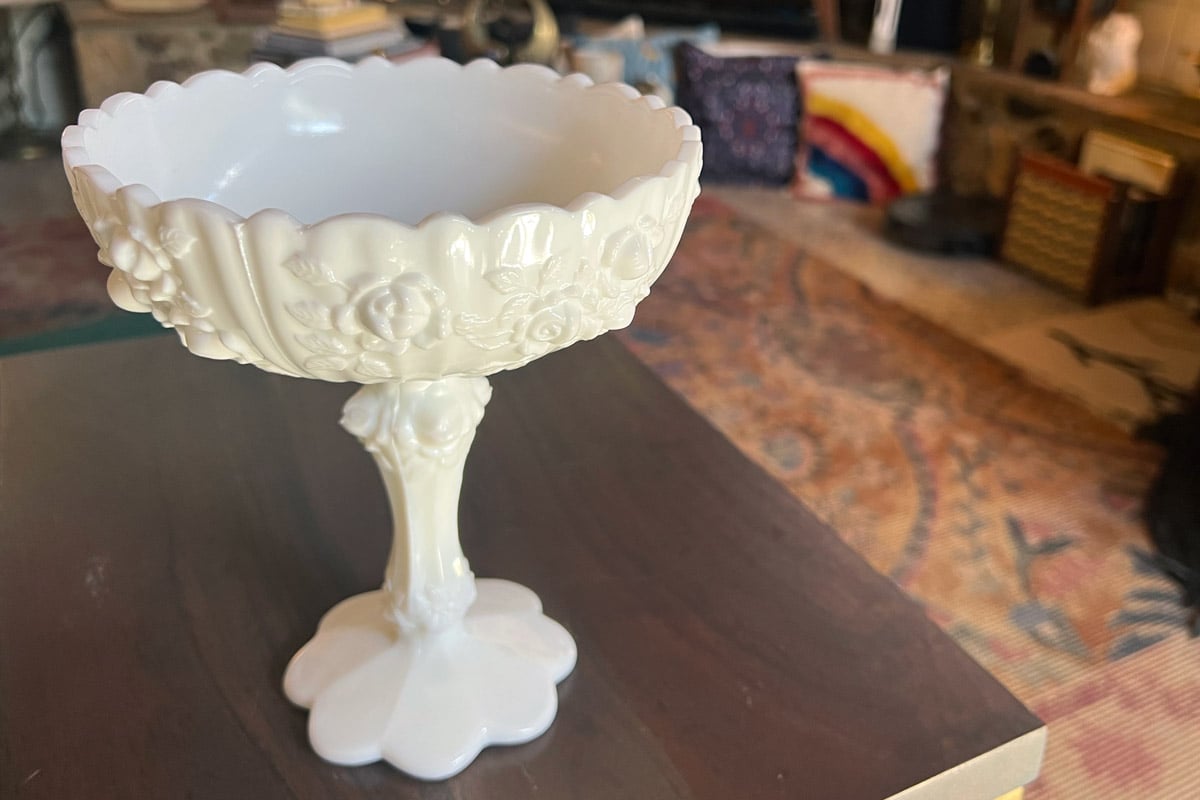Vintage Thrifting Tips From a Pro: How to Find Deals and Valuable Items

Vintage thrifting is more than a hobby for me.
My home is almost exclusively adorned with eclectic vintage items I found at thrift shops. Some of my favorites include a silver blimp cocktail shaker I picked up for $6, a set of heavy brass swan bookends I snagged for $12 and a maroon midcentury tapered-leg chair with a matching ottoman I got for $125.
I’m over the moon when I come across a vintage find at a good price that fits into my decor.
But I don’t just thrift for my own home. I also peruse the secondhand stores for deals that can make me money on the retail market. A recent flip? I sold a big vintage school map for $100. I picked it up for $8.
It’s safe to say I know my way around thrift stores. I’ve been frequenting them for more than 15 years, seeking out vintage thrift finds for my own home and to sell. And in that time, I’ve learned a lot about saving money, identifying quality items and giving new life to worn wares.
Want to hit the thrifts for vintage finds but don’t know where to start? Read on.
Vintage Thrifting Tips for Saving Money and Time
The shelves at thrift stores are packed with treasures and trash alike. Here are my top vintage thrifting tips to tell the difference.
- Keep your purpose in mind.
- Make a plan.
- Identify your find.
- Be wary of dupes.
- Keep an eye out for things you need.
- Evaluate any damage.
- Should you haggle?
- Register for rewards and plan for discount days.
- Find your people.
Make Money to Fund Your Vintage Thrifting Adventures
Need some extra cash to fund your vintage thrifting adventures? From completing short surveys to trying out apps, these are some of our favorite ways to make quick money.
| Offer | What You Can Earn | What You Have to Do | Take Action |
|---|---|---|---|
| InboxDollars | $225/month | Complete short surveys | |
| FreeCash | $1,000/month | Simple online tasks | |
| GoBranded | Up to $140/month | Share your honest opinion | |
| Kashkick | $1,000/month | Try out apps | |
| Solitaire Cash | Up to $83 per win | Compete against other players |

Keep Your Purpose in Mind
Why are you thrifting? Are you hunting for a deal on a new side table for your living room or are you looking for items to flip? There’s a big difference.
When I’m looking for myself or a gift, I’m willing to spend a few more bucks than I am if I’m searching for something to add to my resale inventory.
If you’re reselling, it’s important to think about your margin, especially if you have to consider shipping costs.
For instance, I recently found a vintage Fenton glass candy dish for $3.99. It goes for about $15 online, but I bought it as a catch-all for my bedside table. I wouldn’t have bought it to flip because the margin just isn’t there. Why? It’s glass, so it’s heavier and I’d have to spend extra for bubble wrap to ship it. Ultimately, I’d only end up with a buck or two profit at most, not including my time or gas, and that’s not worth it to me.
Make a Plan
When I set out to do some vintage thrifting, I make a list of all the stores in my area and nail down an itinerary. This way you’re hitting as many as possible in the shortest amount of time. I also like to keep bags and boxes (and some extra newspaper in case I need to wrap glass) in my car, too.
As for where to find vintage items: Thrift stores rely on donations for their inventory. That means that what they have for sale in-store is dependent on what folks donate.
That being said, some stores do have dedicated boutique areas, where they feature vintage and/or higher-end items. (And their price tags usually reflect that.)
Antique stores are a good place to find vintage items, but again, you’ll likely pay more.
And you can always broaden your search and hit up yard and estate sales, which usually have accompanying photos on websites or social media.
ID Your Find
I love a good deal, and thrift stores are full of them. But sometimes, prices for secondhand goods — especially vintage stuff — are inflated. This is where you need to know your product. I’d consider myself an expert on a few types of items, but for everything else, I have my phone handy.
A lot of vintage goods have maker’s marks that make it fairly simple to ID a product with a quick Google search. An example: My aforementioned Fenton dish has a cursive “Fenton” stamp on the bottom.
But if I can’t determine what I’m looking at, I use Google Lens, a photo search feature on the Google app, which is available for iPhones and Androids. Just snap a photo of your find and similar images come up. Usually, you’ll see listings on sites like eBay and Etsy, where you can confidently determine a fair price for your find.
Be Wary of Dupes
Depending on your purpose, this is a biggie. If I’m buying for my home, I truly don’t care if I find a Murano Glass dupe or a real Murano as long as I like it. It does matter, however, if you’re reselling. A knockoff won’t be worth nearly as much as the real deal.
There are ways to ID real Murano Glass, and just about everything else. If I’m unsure about the authenticity of an item, I search “how to identify authentic (enter item here)” or “(item) fakes.”

Keep an Eye Out for Other Items You May Need
I’m all about efficiency. While I’m out and about shopping for vintage finds, I’m always looking for household items we use or need. For instance, I found a nearly new Bodum pour-over coffee maker for $4. (We have been known to break those.) I’ve also found extra plates and serving bowls that coordinate with my everyday dishes, at well under retail.
Evaluate Any Damage
It’s a thrift store, after all. Here are some ways to check for and evaluate damage of vintage items.
Check the Packaging
Packing tape can absolutely destroy a vintage item. Many stores use it to keep multi-piece items together, but it can remove painted design, graphics or gold leafing, and it can destroy old cardboard items like board game boxes. When I come across a taped item, I typically peel a bit of the tape back to see if there’s any obvious damage.
Glassware and Dishes
I can’t tell you how many times I’ve come across a gorgeous set of vintage cups only to discover chips or cracks. I nearly cried when I found a set of four vintage Culver rocks glasses at a thrift store, but one was shattered. It had been damaged because of the way the store packaged the set — stacked on top of each other with no padding. We ended up buying the other three for $2.99 (an absolute killer deal for Culvers) but when we got home, we found that another was chipped. So now we have two.
For glassware, I usually inspect the cup thoroughly and, if I can, lightly run my finger around the rim of the glass to feel for chips. (Please be careful doing this — you don’t want to cut yourself.) This works with other vintage glass things — decorative bowls, vases, ashtrays and more.
Electronics
For electronics, many stores have plug hubs to test items or tags indicating the item has already been tested. But if an electronic item isn’t working, it’s a little harder to tell what the issue may be and if you want to take it on. Personally, I wouldn’t try to rewire a stereo system, but I’ve rewired a few lamps (and one metronome) I thought were iffy safety wise. A rewiring kit for a lamp is usually under $15, well worth the price for peace of mind. (If you’re selling a rewired lamp, though, don’t forget to factor the rewire cost into your listing price.)
Can You Survive 10 Days of Budgeting?
If you need to wrangle your budget, it may be time to consider a savings challenge. Our 10-Day Savings Challenge will teach you how to make your money work for you with a high-yield savings account, stop overpaying on Amazon, earn money for trying out apps or watching movie previews and more.
Vinyl Records
I’ve got a pretty substantial collection of vinyl records, and I’d estimate that 85% of them I bought secondhand. The most important thing to me is the condition of the actual record. Check for warping and scratches. Make sure the sleeve is in decent enough condition to hold your record. If you’re selling, though, things get more complicated. Here’s our guide to selling vinyl records.
Furniture
This one can be a bit trickier. Furniture repair can be super expensive. And considering it’s typically a bigger investment, you want something that’ll last.
Check a piece’s joints for sturdiness. Look for stains in the upholstery. Evaluate the stain or veneer. It’s a good idea to check for bed bugs as well. Signs of bed bugs include reddish or rusty stains caused by the bugs being crushed, dark spots — bed bug excrements — tiny, pale yellow eggs and egg shells, and of course, the bugs themselves.
And take a whiff, too. If it’s just musty, it may need a good airing-out and a few spritzes of Febreeze. But some smells aren’t so easy to get out, like pet urine. I carry around a small black light flashlight to ID stains. (And uranium glass! The real stuff glows under a black light.)
On a couch or chair, I typically do the tried-and-true butt test — just sit on it. Does it feel sturdy? Is it comfortable? Do the cushions feel worn?
If there are imperfections, you’re now faced with a choice: To fix or not to fix. Depending on your skill set and resources, that is the question.
Yes! You Can Fix Some Stuff
I’ve walked away from many a vintage treasure after discovering irreparable damage. Some stuff is fixable, though. If it’s just dirty, you can clean it, and there are lots of cleaning supplies out there for your vintage thrift finds.
I should buy stock in Brasso, a metal-cleaning agent that comes in handy for my extensive brass collection. It also works on copper, chrome, bronze, stainless steel, pewter and aluminum. Get some soft-bristled toothbrushes and microfiber cloths (I buy mine from The Dollar Tree) and you’re in business to polish up nearly any metal.
Found some glasses with water spots? Some come out after a soak in hot water. If you need a little extra umph, buy a pack of denture cleaning tabs, so long as the glasses don’t have any paint or leafing. Denture cleaners do wonders on water spots. I get those at The Dollar Tree, too.
You can often buff out scratches on dishes with a Mr. Clean Magic Eraser. (The Dollar Tree knockoff is effective, too.)
For wood furniture with scratches — Old English Scratch Cover is a miracle product and it comes in a variety of colors for about $6 a bottle.
And wood glue. I’ve got a few bottles of Gorilla Wood Glue around the house. I use it mostly for furniture repair — this stuff is strong.
Should You Haggle?
Many thrift stores are traditional retail establishments with set prices and don’t allow haggling. Some also have signs relaying their haggling policy. If you don’t know, it’s totally fine to ask if prices are negotiable. But, like with all things, do it politely.
However, if your search for vintage goodies leads you to a flea market or estate sale, you may find some additional flexibility in pricing. The same rule still applies, though: Be polite.
Register for Rewards and Plan for Discount Days
Many thrift stores have rewards programs. Sign up for them. One local thrift shop I frequent gives me $5 after I’ve spent a cumulative $100. All I had to do was give them my phone number. It took a few shopping trips to get to $100, but that $5 reward on top of the other good deals I find is pretty great.
Lots of places have senior- or student-discount days. In my area, the Goodwills have a weekly tag color that indicates which items are half off.
Following your favorite stores on social media is a good idea, too. That way you’ll see what kinds of sales they’re running, and in some cases, items they’re selling.

Find Your People
My style is all over the place. I’m curating a tiki bar in my home. I have a collection of creepy cat figurines and a China cabinet chock-full of midcentury cocktail glasses. I’m into sleek, tapered-legged furniture and loud printed throw pillows.
I’ve found my people on social media, in groups focused on midcentury decor, tiki culture and maximalism. I get inspiration, camaraderie and some help IDing items I may not know.
Finding these communities can be crucial for helping you find and understand the items you’re into.
Happy hunting!
Is Your Paycheck Not Going As Far As It Used To?
We get it. Everything is more expensive than it used to be, but your paycheck hasn’t kept up.
When money is tight, these resources will help nearly everyone.
Katie Sartoris is the senior editor of freelance for The Penny Hoarder. She’s an award-winning journalist with a decade of reporting and editing experience. She formerly was a local news editor for a Gannett newspaper in Central Florida.















